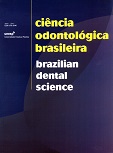Torque de remoção de parafusos em pilares protéticos com conexão tipo hexágono interno após ciclagem mecânica
DOI:
https://doi.org/10.14295/bds.2007.v10i4.300Abstract
O sucesso no tratamento reabilitador protético realizado sobre implantes ósseo-integrados pode ser comprometido por falhas mecânicas em seus componentes, tais como desajuste e até mesmo fraturas dos componentes protéticos quando expostos à função mastigatória. O presente estudo teve por objetivo avaliar, in vitro, o desajuste ocorrido na interface implante-intermediário por meio da aferição e comparação do torque inicial utilizado para a colocação do parafuso de fixação dos pilares protéticos em implantes com hexágono interno, com relação ao torque necessário para remoção dessas estruturas antes e após a simulação da função mastigatória. Testes de ciclagem mecânica foram induzidos sobre os pilares protéticos. Mediu-se o torque de remoção dos parafusos de fixação dos pilares proteticos. Houve diminuição significativa nos valores de torque de remoção de todas as amostras, e a perda foi ainda maior nas amostras submetidas à ciclagem mecânica. Os dados obtidos permitem supor que há sempre diminuição nos valores de torque de remoção desses componentes e que a função mastigatória aumenta a probabilidade de desajuste na interface implante-pilar protético.Downloads
Downloads
Published
How to Cite
Issue
Section
License
Brazilian Dental Science uses the Creative Commons (CC-BY 4.0) license, thus preserving the integrity of articles in an open access environment. The journal allows the author to retain publishing rights without restrictions.
=================




























